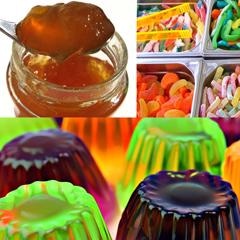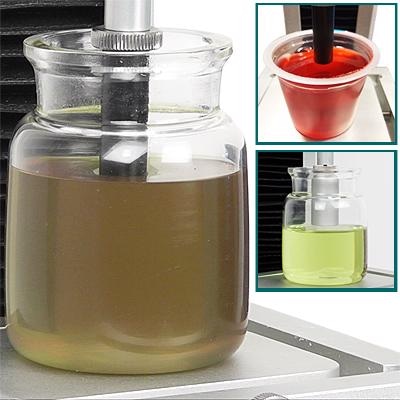In the food industry, gels are frequently used as a binding agent, whipping agent, thickener, stabilizer, and adhesive, amongst many other functions (Figure 1). These ingredients are used in many products because they are highly versatile and effectively processed. Bloom strength tests are standardized tests performed to grade and qualify the gelling characteristics of gelatin. Other agents, like hydrocolloids, can be evaluated in a similar manner.

Figure 1. Various products using gel ingredients
The cosmetics and pharmaceutical industries also use gelling agents to create required textural properties. Standard gel products that are tested include pectin, agar, alginates, mixed polysaccharides, gelatin, carrageenan, starch gels, xanthan gum, Tara gum, and surimi.
Benefits of Gel Texture Testing
Gel texture testing offers several benefits. For instance, it can be used to improve the functions of ingredients, as well as the blend properties of edible gelatins for both commercial and industrial markets; it can be used to control raw materials and ensure quality payment between processors, producers, and consumers; and it can be used for formulation and development of products to obtain the highest functionality from the gelatin.
Test Methods for Gels and Hydrocolloids Sector
The functional characteristics of hydrocolloid gels, such as elasticity and firmness, are often determined through instrumental measurements (Figure 2). This is done by compression, or sometimes by penetration of a sample’s surface. The determination of strength in gelatins and other gelling agents forms an important part of their grading and quality evaluation.

Figure 2. Gel testing images in Bloom bottle and product container.
The way that the sample and the test conditions are prepared is vitally important as they can directly influence the way that the sample responds to testing. As most hydrocolloid systems are marketed on the strength of their functional properties, accuracy, and reproducibility of results are vital.
The Bloom Strength Test
The industry standard Bloom strength test is a long-established method and is a key example of standardized gel testing. This testing method was initially established in the British Standards Method (B.S. 757:1975), and since then has been changed by the Gelatine Manufacturers of Europe (GME). It clearly defines the sample preparation, test conditions (such as test probe, trigger point, speed, and deformation distance), and the instrument specification to be used for performing the test. The test involves a controlled compression of the sample‘s surface, leading to an experiential test technique that applies the basic rules for control and standardization.
Gelatin manufacturers have established a standardized method because gelatins are graded by their Bloom value, where higher values pertain to higher costs. As a result, quantified uniformity is important in a global commercial market. The Bloom strength corresponds to the force needed for gel deformation, with values usually in the range of 50 to 300. Values that are above 200 are graded as high; those that are less than 120 are graded as low, and those in between are graded as medium strength.
Gel Testing Fixtures
In Bloom strength testing, certain fixtures and accessories need to be used. The probes and gel sample bottles have accurate specifications with regard to materials and dimensions. Gel industry fixtures supplied by Mecmesin meet ISO 9665, BS757, AOAC 1985, and GME standards.

This information has been sourced, reviewed and adapted from materials provided by Mecmesin.
For more information on this source, please visit Mecmesin.